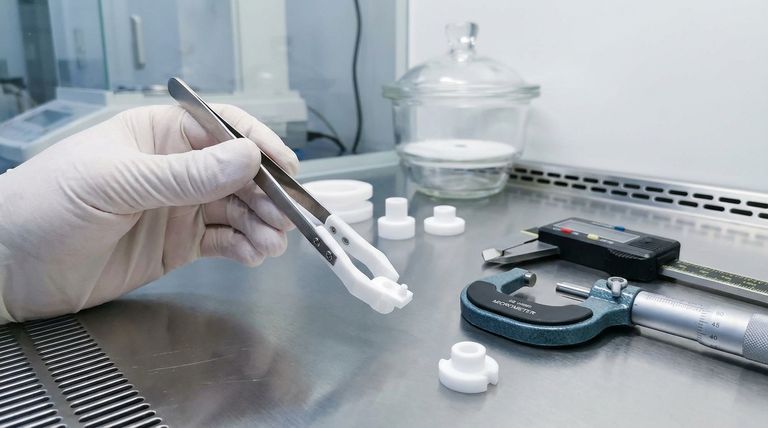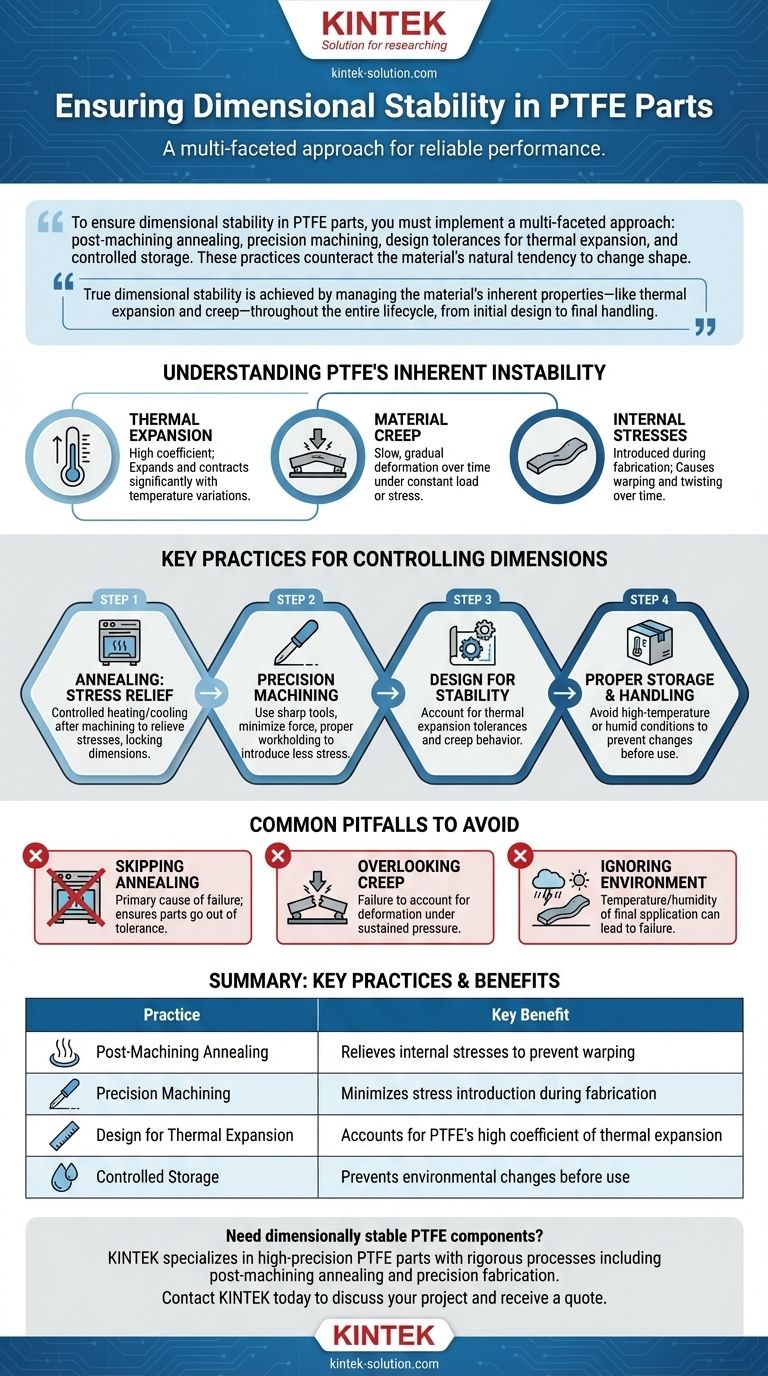To ensure dimensional stability in PTFE parts, you must implement a multi-faceted approach. This includes post-machining annealing to relieve internal stresses, designing with tolerances that account for thermal expansion, using precision machining techniques with sharp tools, and controlling storage environments to prevent temperature-induced changes. These practices work together to counteract the material's natural tendency to change shape.
The core challenge with PTFE is not just manufacturing a part to specification, but ensuring it stays to specification. True dimensional stability is achieved by managing the material's inherent properties—like thermal expansion and creep—throughout the entire lifecycle, from initial design to final handling.

Understanding PTFE's Inherent Instability
Polytetrafluoroethylene (PTFE) is a uniquely flexible and versatile polymer, but its properties can make achieving tight tolerances a challenge. Understanding why it moves is the first step to controlling it.
The Impact of Thermal Expansion
PTFE has a high coefficient of thermal expansion, meaning it expands and contracts significantly with temperature variations. A part machined to perfect dimensions in a cool shop may be out of tolerance in a warmer operating environment.
The Challenge of Creep
Under a constant load or stress, PTFE is prone to creep, which is a slow, gradual deformation over time. This behavior must be accounted for in the design phase, especially for components that will be under mechanical pressure.
Internal Stresses from Fabrication
The process of machining or molding PTFE introduces internal stresses into the material. Over time, these stresses will naturally try to relieve themselves, causing the part to warp, twist, or change dimensions.
Key Practices for Controlling Dimensions
A disciplined process is required to produce a stable and reliable PTFE component. Each step plays a critical role in the final outcome.
Annealing: The Critical Stress Relief Step
Annealing is a controlled heating and cooling process performed after machining. This step is essential for relieving the internal stresses introduced during fabrication, effectively "locking" the part into its final, stable dimensions.
Precision Machining Techniques
The goal during machining is to introduce as little stress as possible. This is achieved by using extremely sharp cutting tools, minimizing cutting force, and employing proper workholding techniques to secure the part without deforming it.
Designing for Stability
Effective design is proactive. Engineers must design parts with sufficient thermal expansion tolerances to accommodate expected temperature changes. The design should also account for the material's creep behavior to ensure long-term performance under load.
Proper Storage and Handling
The part's stability can be compromised after it leaves the machine. Parts must be stored in a controlled environment, avoiding high-temperature or humid conditions that could cause them to expand or contract before they are even used.
Common Pitfalls to Avoid
Achieving dimensional stability often means avoiding common but costly mistakes.
Skipping the Annealing Step
Attempting to save time or cost by skipping the post-machining annealing process is a primary cause of failure. This almost guarantees that internal stresses will cause the part to go out of tolerance over time.
Overlooking Material Creep
Designers accustomed to metals or more rigid plastics may fail to account for creep. A design that looks perfect on paper can fail in the field if it doesn't accommodate for PTFE's tendency to deform under sustained pressure.
Ignoring Environmental Context
A part is only as stable as its environment allows. Failing to consider the temperature and humidity of the final application can lead to a perfect part failing due to predictable expansion or contraction. Sourcing from a supplier with a robust quality system, such as ISO 9001 certification, helps ensure these process controls are consistently followed.
How to Apply This to Your Project
Your strategy should align with the specific demands of your application.
- If your primary focus is high-precision components: Prioritize a multi-stage process of rough machining, followed by annealing, and then a final finish machining pass.
- If your primary focus is long-term reliability under load: Your design must explicitly account for PTFE's creep characteristics and include tolerances for thermal expansion.
- If you are sourcing finished parts: Verify that your supplier uses post-machining annealing as a standard procedure for all dimensionally critical components.
By respecting PTFE's unique material properties through a disciplined process, you can transform its potential instability into predictable, reliable performance.
Summary Table:
| Practice | Key Benefit |
|---|---|
| Post-Machining Annealing | Relieves internal stresses to prevent warping |
| Precision Machining | Minimizes stress introduction during fabrication |
| Design for Thermal Expansion | Accounts for PTFE's high coefficient of thermal expansion |
| Controlled Storage | Prevents environmental changes before use |
Need dimensionally stable PTFE components that perform reliably?
KINTEK specializes in manufacturing high-precision PTFE seals, liners, labware, and custom components for the semiconductor, medical, laboratory, and industrial sectors. Our rigorous process, including mandatory post-machining annealing and precision fabrication, ensures your parts meet exact specifications and maintain stability under load and temperature variations.
We offer custom fabrication from prototypes to high-volume orders, backed by a commitment to quality.
Contact KINTEK today to discuss your project requirements and receive a quote.
Visual Guide

Related Products
- Custom PTFE Parts Manufacturer for Teflon Parts and PTFE Tweezers
- Custom PTFE Parts Manufacturer for Teflon Containers and Components
- Customizable PTFE Rods for Advanced Industrial Applications
- Custom PTFE Teflon Balls for Advanced Industrial Applications
- Custom PTFE Square Trays for Industrial and Laboratory Use
People Also Ask
- What fabrication services are available for PTFE? Shearing, Stamping, Laser Cutting, Molding & Machining
- What design considerations are important for custom PTFE parts? Design for Performance & Reliability
- What are the main applications of PTFE type Teflon? Unlock Its Versatility for Your Industry
- What factors should be considered when choosing between Nylon and PTFE? Select the Right Material for Your Application
- What industrial benefits do PTFE-machined parts offer? Achieve Peak Performance in Demanding Applications



















